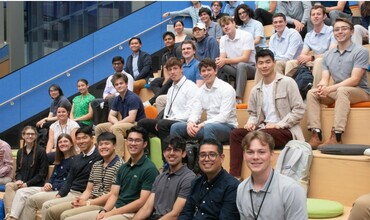The Draper Scholars Program emphasizes empowering students in 16 key research areas to make the greatest impact. We encourage applicants to align their research with these topics.
RF and Communications
RF and Communications technology is fundamental to the programs Draper performs for all our Government and Commercial sponsors. We are interested in working with PhD students who will be developing fundamentally new approaches, and MS students who are applying known techniques to new problem spaces.
Technical Point of Contact
Research Interests
Understanding Complex Electromagnetic Environments
Many problems involve engaging and rapidly modeling (understanding) complex emission environments, so that a prudent course of action may be taken within the prevailing time constraint. For example, signal surveys have traditionally been accomplished using a fleet of large manned aircraft in a process that is costly, labor-intensive and highly-vulnerable. As these missions migrate toward drones or proliferated LEO constellations, there is an acute need for all the technologies required to complete the system, such as low power, lightweight, wideband receivers, efficient signal identification algorithms, and efficient propulsion and platform control.
Range, Rate, Robustness
All communications systems suffer performance degradations due to fluctuations in the propagation and interference environment, and changes in the offered load or quality of service requirements. There is an acute need for (potentially) cross-layer hardware and algorithmic approaches to ensure the user receives adequate performance as the underlying network varies. Of particular interest is techniques that are efficient, meaning they consume few resources while performing continuous optimization.
Privacy and Secrecy
Communications privacy and secrecy have traditionally been supported through the use of encryption and spread spectrum techniques. As these techniques have proliferated, so too have the countermeasures, to the point where traditional techniques provide only pro forma value. There is an acute need for communications techniques that evade detection through the use of advanced waveforms, or spatial field distributions, and do so while giving the user a “knob,” to select a tradeoff between privacy, data rate, and other key system parameters.
Acoustic and Vibration Technologies
Draper develops technologies that detect, process, and produce sound and vibration signals for a variety of sensing and communication systems. These deployable solutions provide the situational awareness and resilience required for effective operation under a variety of conditions. We are seeking research partners in the fields of underwater and airborne acoustics, bioacoustics (speech, human performance, etc.), active noise and vibration control, and other related fields to answer questions such as:
- How can acoustic signals be fused with signals from other sensing modalities to enhance detection, classification, and identification?
- How can we optimally collect and process acoustic signals from sensor arrays to localize and track events of interest?
- How can we design algorithms that effectively detect when an acoustic event of interest has occurred and extract key information in the presence of noise?
- How can we design low-bandwidth acoustic communication systems to support a variety of operational scenarios?
- What novel and/or non-traditional acoustic sensors could be developed to extract key information from austere environments?
Harsh Environments
Many of the most important communications problems must operate reliably in an environment that is well beyond the capability of commercial off the shelf (COTS) electronics. For example all of our cislunar deployments, as well as reactor control systems, must be radiation hardened. Similarly, many industrial applications need to work reliably at temperatures exceeding 500C. There is an acute need for research that extends wide- and ultra-wide- bandgap device design and operation into higher temperature regimes, and SOI devices into higher frequency regimes.
Have Any Questions?
To learn more or stay up to date with our key areas, please fill out the below contact form.

